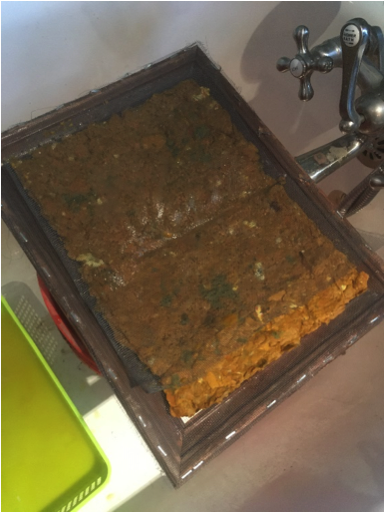By Alyssa Dyar

Eva Hesse’s work Repetition 19 III is an example of repeating form as a process.
At Ignite Studio one of the guidelines on our Patron Bill of Rights reads: “It’s about the process not about the product.” What does that really mean? Historically, process art was a movement that took off in the 1960’s in America and Europe. Process art focuses on actions—how they are initiated and how they proceed. These actions can be improvisational or preplanned but always methodical in some way. Whatever the method—whether it be gathering, sorting, collating, associating, or patterning—process art is always rooted in human expression. Jackson Pollock and Eva Hesse are two process artists that practice methodical process art.

Jackson Pollack dripping paint over a canvas.
I have been collecting egg cartons for about six months. I use them as planters to start seeds for my garden. Turns out I’ve been eating a lot of eggs this year because after starting my seeds I had so many extras! I didn’t want to toss them in the recycling bin. I decided that since they would probably just end up being recycled into paper products, I could try to make my own paper out of egg cartons. Before I got started, I had a lot of questions I needed answered, which is one of the beginning stages of experiencing process art:
- What would it look like?
- Would it mold?
- Would it hold together?
Can egg cartons be made into paper at home?
 There’s only one way to find out: follow the paper-making process and experiment. Below I’ll show you the steps I took. I encourage you to give it a try yourself!
There’s only one way to find out: follow the paper-making process and experiment. Below I’ll show you the steps I took. I encourage you to give it a try yourself!
Materials
- Water
- Fibrous material (to break down and turn into pulp)
- Screen (to let the water strain through but allow the fibrous material to hold shape)
- Sponges or cloth (to absorb the excess water)
Process
The process for making paper is fairly simple on paper (haha). In action though, it is labor intensive.
First soak your material. In this case, I am soaking beautiful egg cartons.
After soaking for many hours, blend your material. Since the egg cartons were pretty thick, I used a drill and a paint mixer attachment to turn it into pulp.
Then distribute the pulp over a screen to catch and shape the pulp while much of the water drips out. Place another screen on top of the pulp to squeeze more water out. The deckle (paper mold) I was using started to break and bend when I squeezed the water out so I had to improvise a less conventional method. Instead of letting this beautiful pulp go to waste, I took a much bigger screen for a window and put it outside on the grass. Then I poured the pulp over the screen. I used a smaller screen and a sponge to absorb the water from the top of the pulp while the grass absorbed the water from the bottom.
Finally, allow the paper to dry fully before removing from the screen.
Outcome
 During this process I felt something I haven’t since the stay-at-home order was put in place—calm. I was present in my environment working on something that was exciting but also familiar. The paper I made isn’t the prettiest paper I’ve ever seen; the edges aren’t perfect, and I’m not sure there’s much of a practical use for it. It is beautiful though. It tells a story of how it was made and of what. It’s a documentation of movement, thoughts, passing time, and even the weather. When I look at it I remember the way I felt when I was making it, and it encourages me to try again.
During this process I felt something I haven’t since the stay-at-home order was put in place—calm. I was present in my environment working on something that was exciting but also familiar. The paper I made isn’t the prettiest paper I’ve ever seen; the edges aren’t perfect, and I’m not sure there’s much of a practical use for it. It is beautiful though. It tells a story of how it was made and of what. It’s a documentation of movement, thoughts, passing time, and even the weather. When I look at it I remember the way I felt when I was making it, and it encourages me to try again.
I finished this process feeling intrigued by more questions:
- What can I do with this egg carton paper?
- Can I make it into different shapes?
- Can I make a three-dimensional form with it?
- What else can I make paper out of that’s lying around the house?
Only one way to find out…






